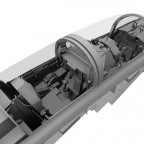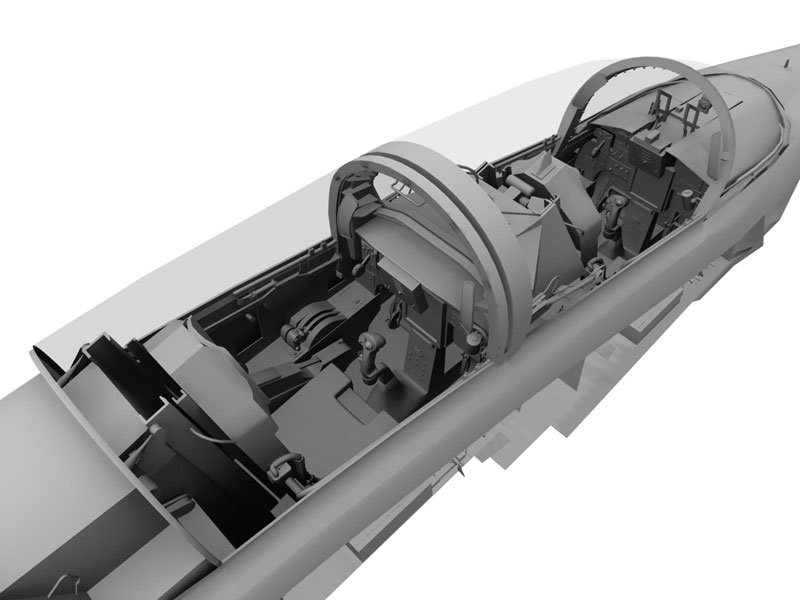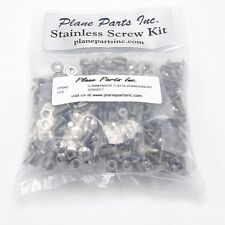20mm: It is clear the Fighter Ops is a project that intends to break new ground (and the mold) in the world of computer flight simulations. From the high fidelity flight model, to systems and avionics, air frames, engine and thrust data, modeling system failures, authentic sounds, global spherical terrain, weather, detailed airports, cutting edge graphics and more. With such detail, how difficult is it to integrate all of this into one flyable aircraft on a personal computer?
Rick: The biggest challenge is to have these modules communicate with each other effectively. For example the flight model, aircraft systems and avionics, the weather engine and the terrain module all communicate with one other. Each of these, and indeed many of the other modules involved in the program, view the game-world from many different perspectives and don’t necessarily represent game-world data in compatible formats. So meshing these incompatibilities into a uniform package represents a very high degree of technological elegance. The other major challenge is to run all the modules at an interactive rate. Each of these modules acts as full-fledged simulations in themselves, and having all of them run simultaneously and efficiently is no trivial task in itself.
20mm: Honestly, is it doable at this point in time, or is it something that will have to evolve?
Rick: Every product inevitably evolves over time. This will be as true for Fighter Ops as it has been for all other flight simulation programs. The point is that for Fighter Ops the features that we have announced to date will be in the first release. Will these features evolve? Absolutely! When new hardware becomes available, new patches will enhance the existing features to work more effectively on new hardware and take advantage of what they have to offer. Are the published features all Fighter Ops will have when it is released? Absolutely not! There are many ground breaking features that are being implemented for the first release, but for obvious reasons we prefer not to discuss them at this time. A few of these other features (ones that we have not announced, but are being working on) may not make it to the first release, in which case, they will be added to Fighter Ops in future versions as it evolves.
 20mm: I’d like to expand on my observation about the ambitious nature of the FO project. I know this is a hard question to answer, but there are instances in computer simulation history of developers trying to do “too much”. While the goals are admirable and the anticipation is intense, the deeper and deeper the dev team gets into the nitty-gritty, the more they discover that certain things just are not possible given the current state of personal computer power and software capabilities. Is it possible that the team may have bitten off more than it can chew?
20mm: I’d like to expand on my observation about the ambitious nature of the FO project. I know this is a hard question to answer, but there are instances in computer simulation history of developers trying to do “too much”. While the goals are admirable and the anticipation is intense, the deeper and deeper the dev team gets into the nitty-gritty, the more they discover that certain things just are not possible given the current state of personal computer power and software capabilities. Is it possible that the team may have bitten off more than it can chew?
Rick: For the most part, I refer you to the answer I gave to a previous question; however, I should add that if “all” the planned features for the first release are taken into account; “too much” will have to be redefined. With that said, we do believe that the features we have planned for the first release are all within reach, given the current state of technology, available algorithms and accessible software.
20mm: Talk about what we can expect with the cockpits. I understand they’re going to be 3D with a clickable cockpit interface, correct?
Rick: The cockpits are going to be very accurate in terms of the visual representation of instruments and instrument placement. You can expect the cockpits to be fully 3D and animated. Interaction with the cockpit is possible using the keyboard (to get things done faster), the mouse and a few other means.
20mm: Will they have a “weathered and worn” look, or like the aircraft just rolled off the production line?
 Rick: We are developing a system of dynamic weathering for our aircraft. Specifically, as you advance through a campaign, your aircraft will become progressively more “weathered and worn.” This system will use variables such as the accumulation of stress to the surface from use and abuse of the aircraft, as well as environmental factors such as climate, etc. We also plan to include routine maintenance, which will at regular increments decrease, but not eliminate entirely, some of the effects of age and weather. A good wash does not fix dents, scratches, and worn paint, but only removes surface dirt. In addition, we will be able to give an old airframe a fresh coat of paint, but surface imperfections such as dents will still show. The age of a user’s “‘new” aircraft will be selectable by the user. That is, users will have the ability to choose between an airplane direct from the factory or a used airplane with a new coat of paint.
Rick: We are developing a system of dynamic weathering for our aircraft. Specifically, as you advance through a campaign, your aircraft will become progressively more “weathered and worn.” This system will use variables such as the accumulation of stress to the surface from use and abuse of the aircraft, as well as environmental factors such as climate, etc. We also plan to include routine maintenance, which will at regular increments decrease, but not eliminate entirely, some of the effects of age and weather. A good wash does not fix dents, scratches, and worn paint, but only removes surface dirt. In addition, we will be able to give an old airframe a fresh coat of paint, but surface imperfections such as dents will still show. The age of a user’s “‘new” aircraft will be selectable by the user. That is, users will have the ability to choose between an airplane direct from the factory or a used airplane with a new coat of paint.
20mm: Still on the topic of cockpits, I gather there will be a detailed ejection sequence unlike the typical “push a button and the next thing you know you’re hanging from the chute” deal. What can we expect when things go bad and we have to punch out?
Rick: An advanced ejection sequence simulation is planned with an integrated stand-alone ejection seat operational model. We are doing our best to model it as accurately as possible, and many hours of research and development time have gone into making the ejection sequence as realistic as possible.
20mm: From the early days, I understood that the basic engine of Fighter Ops would be X-Plane®. Is that still true, or has the development platform changed so much over the years that it really has morphed into a wholly separate entity and could never be compared with its starting point?
Rick: The basic perception was to use an earlier X-Plane shell as the foundation for the Fighter Ops engine. However, over time we slowly reduced the amount of nonessential code that was once considered necessary for our build. For instance, the X-Plane code was never present in our graphics engine which at this time consists of a high-end DX10 engine, a high-end to mid-range DX9 version and another for very low-end graphics. Conversely though, smaller parts of the code were present in earlier builds. At this point in time, we are completely free of all external code. So to answer your question, Fighter Ops will not have any external legacy code and non-code content from any other outside source, including X-Plane.
 20mm: What’s the copy protection system for FO? I’ve read some reports by FO team member “Buckshot” on this, and I see that the team clearly understands the frustration of the simulation community in this respect.
20mm: What’s the copy protection system for FO? I’ve read some reports by FO team member “Buckshot” on this, and I see that the team clearly understands the frustration of the simulation community in this respect.
Rick: The fact is that the availability of pirated versions of any software does not depend on the copy protection scheme employed by the developers. The only thing that counts is the success of the software; and if it exceeds a certain threshold, pirated versions will inevitably appear. We have yet to see a successful copy protected program that has not been pirated (yes, even games using Starforce have been pirated, although not conveniently in some cases).
Companies invest a great deal on more complex copy protection mechanisms, yet the pirates need only a few weeks to crack the most advanced copy protection. The pirate and users of pirated software face absolutely no difficulty in what they are doing. The only real victim here is the legitimate user who is being treated like a thief and inconvenienced in different ways.
Various activation-based protection schemes are not attractive either. The experience the user has is that he/she does not own the software that they have purchased; and whether the software ends up being activated depends on the software developer/publisher.
We will most likely keep the copy protection aspect of Fighter Ops limited to online activities and in general, anything that requires the Internet. Offline single-player use of the product will not force the user to jump through hoops to get the software to work.













